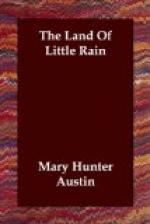There are three kinds of noises buzzards make,—it is impossible to call them notes,—raucous and elemental. There is a short croak of alarm, and the same syllable in a modified tone to serve all the purposes of ordinary conversation. The old birds make a kind of throaty chuckling to their young, but if they have any love song I have not heard it. The young yawp in the nest a little, with more breath than noise. It is seldom one finds a buzzard’s nest, seldom that grown-ups find a nest of any sort; it is only children to whom these things happen by right. But by making a business of it one may come upon them in wide, quiet canons, or on the lookouts of lonely, table-topped mountains, three or four together, in the tops of stubby trees or on rotten cliffs well open to the sky.
It is probable that the buzzard is gregarious, but it seems unlikely from the small number of young noted at any time that every female incubates each year. The young birds are easily distinguished by their size when feeding, and high up in air by the worn primaries of the older birds. It is when the young go out of the nest on their first foraging that the parents, full of a crass and simple pride, make their indescribable chucklings of gobbling, gluttonous delight. The little ones would be amusing as they tug and tussle, if one could forget what it is they feed upon.
One never comes any nearer to the vulture’s nest or nestlings than hearsay. They keep to the southerly Sierras, and are bold enough, it seems, to do killing on their own account when no carrion is at hand. They dog the shepherd from camp to camp, the hunter home from the hill, and will even carry away offal from under his hand.
The vulture merits respect for his bigness and for his bandit airs, but he is a sombre bird, with none of the buzzard’s frank satisfaction in his offensiveness.
The least objectionable of the inland scavengers is the raven, frequenter of the desert ranges, the same called locally “carrion crow.” He is handsomer and has such an air. He is nice in his habits and is said to have likable traits. A tame one in a Shoshone camp was the butt of much sport and enjoyed it. He could all but talk and was another with the children, but an arrant thief. The raven will eat most things that come his way,—eggs and young of ground-nesting birds, seeds even, lizards and grasshoppers, which he catches cleverly; and whatever he is about, let a coyote trot never so softly by, the raven flaps up and after; for whatever the coyote can pull down or nose out is meat also for the carrion crow.




